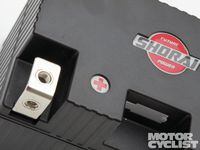On September 3, 2010, a United Parcel Service flight left Dubai bound for Cologne. Shortly after takeoff, a fire alarm sounded on the main deck. Requesting an emergency landing, the crew turned the Boeing 747 back to Dubai. Overcome by smoke, they were unable to land successfully, and the crew and plane were lost in the crash.
The cause of the fire was traced to heat from faulty lithium-ion batteries or battery-powered devices in the cargo hold that had not been labeled as hazardous materials and stored as such. Rules for transporting such batteries and devices have been made much stricter since the crash.
Are lithium-ion batteries unsafe? No, they have very few failures. But there are many millions of such batteries in use in everything from laptop computers to the Mars rover, so even a very low failure rate carries costs. The point is all energy storage presents some risk. Generally, the more energy stored, the greater the risk.
Lithium-ion batteries have about seven times the energy density of traditional lead-acid batteries, which means you can get much more power from a much smaller—and lighter—battery pack. Lithium-ion technology is improving rapidly, and batteries currently under development may eventually have about 90 times the energy storage per unit weight of a lead-acid battery.
Lithium-ion batteries are currently being introduced to the motorcycle industry. Known as LFP (Lithium Ferrous Phosphate) batteries, these use iron rather than cobalt, manganese or nickel in the cathode. They have less energy density than some other lithium-ion batteries, but offer greater chemical and thermal stability—the chemical bonds are stronger, offering more resistance to overheating, vibration and other abuse.
As encouraging as it is to know that LFP batteries are safer than most other lithium-ion types, overcharging, damage and abuse can still cause problems, primarily an inability to hold a charge. Lead-acid and lithium-ion are two entirely different technologies, with different discharge characteristics and charging requirements. As such, it’s important to approach LFP with an open mind and read the FAQ section of manufacturers’ websites to learn about these batteries’ unique—and, for the most part, limited—requirements. Lead-acid batteries are fairly inefficient but also tolerant of abuse. Lithium-ion batteries are highly efficient but susceptible to damage if overcharged or allowed to drain below a certain voltage threshold, usually in the 12V range. Vibration and shock can damage a lithium-ion battery’s internal connections, which is why manufacturers now offer their batteries in OE-sized cases. Batteries that are smaller than a bike’s battery box should be shimmed with foam pads to prevent shock due to unimpeded movement.
For sportbike riders, off-road riders and owners of other performance-oriented machines, LFP batteries are the cheapest, quickest and easiest way to shed pounds, but they’re not for everybody. Lithium-ion batteries are not suitable for bikes with a parasitic draw when the key is turned off, or bikes so laden with accessories that the battery has to supplement the bike’s charging system. Also, LFP batteries can be sluggish in the cold.
Lithium-ion batteries are lightweight but also powerful, providing improved starting performance via a stronger spark and faster-spinning starter. But there’s no free lunch: They cost two to three times as much as lead-acid batteries and need the right kind of maintenance. With care, they should provide good value. MC











/cloudfront-us-east-1.images.arcpublishing.com/octane/VZZXJQ6U3FESFPZCBVXKFSUG4A.jpg)
/cloudfront-us-east-1.images.arcpublishing.com/octane/QCZEPHQAMRHZPLHTDJBIJVWL3M.jpg)
/cloudfront-us-east-1.images.arcpublishing.com/octane/HXOUJXQWA5HBHGRO3EMJIGFMVI.jpg)

/cloudfront-us-east-1.images.arcpublishing.com/octane/3TIWWRV4JBBOLDVGRYECVVTA7Y.jpg)
/cloudfront-us-east-1.images.arcpublishing.com/octane/KIX5O23D5NAIBGFXBN3327DKZU.jpg)
/cloudfront-us-east-1.images.arcpublishing.com/octane/7GJYDUIPXRGMTMQKN6ONYOLBOU.jpg)
/cloudfront-us-east-1.images.arcpublishing.com/octane/MUQLOVLL2ZDGFH25ILABNBXKTI.jpg)
/cloudfront-us-east-1.images.arcpublishing.com/octane/TNOU5DNE2BC57MFPMGN2EIDXAM.jpg)
/cloudfront-us-east-1.images.arcpublishing.com/octane/GTCXACQGJ5HAPDTGWUQKDEH44E.jpg)
/cloudfront-us-east-1.images.arcpublishing.com/octane/S35YGSEMEZB4BLTDJTSZPF4GLA.jpg)
/cloudfront-us-east-1.images.arcpublishing.com/octane/5UOT6HPX2JFMRJAX6EH45AR4MQ.jpg)
/cloudfront-us-east-1.images.arcpublishing.com/octane/OKWOJWAKP5EP3OACCRRWPCIX2Q.jpg)
/cloudfront-us-east-1.images.arcpublishing.com/octane/2WF3SCE3NFBQXLDNJM7KMXA45E.jpg)
/cloudfront-us-east-1.images.arcpublishing.com/octane/G4MG6OUCJNBSHIS2MVVOTPX65E.jpg)
/cloudfront-us-east-1.images.arcpublishing.com/octane/IIGGWFOTOJGB7DB6DGBXCCMTDY.jpg)
/cloudfront-us-east-1.images.arcpublishing.com/octane/QSTCM6AVEZA5JJBUXNIQ3DSOF4.jpg)
/cloudfront-us-east-1.images.arcpublishing.com/octane/U4I7G625B5DMLF2DVIJDFZVV6M.jpg)
/cloudfront-us-east-1.images.arcpublishing.com/octane/B6XD6LS6IVCQPIU6HXDJSM3FHY.jpg)
/cloudfront-us-east-1.images.arcpublishing.com/octane/ICL63FEDDRDTTMINYICCEYGMDA.jpg)
/cloudfront-us-east-1.images.arcpublishing.com/octane/FCGZHQXRBZFLBAPC5SDIQLVF4I.jpg)
/cloudfront-us-east-1.images.arcpublishing.com/octane/WNOB6LDOIFFHJKPSVIWDYUGOPM.jpg)

/cloudfront-us-east-1.images.arcpublishing.com/octane/X33NU3E525ECRHXLNUJN2FTRKI.jpg)